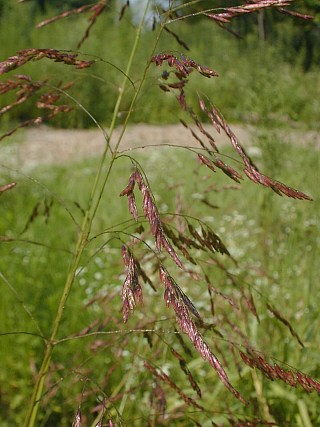 Description: This native perennial grass
is about 3-4' tall and unbranched; plants can occur in tufts or as scattered
individuals. The culm is green, glabrous, and terete (round in cross-section);
the nodes on the culm are glabrous and green to reddish green. The blades of
the alternate leaves are up to 12" long and ½" across; they are linear,
medium green, and flat. Leaf venation is parallel, while the upper surface and
margins of the leaf blade are scabrous (rough to the touch). The sheath of each
leaf is tightly rolled around the culm, medium green, and hairless, except for
a tuft of hairs at its apex. The culm terminates in a panicle of spikelets up
to 1½' long and about half as much across. This panicle becomes widely
spreading and is rather lanky; its branches are very thin and wiry. Each narrow
spikelet is up 10 mm. (1/3 in.) long, consisting of a pair of glumes and 2-4
pairs of lemmas, which are arranged together into 2 columnar ranks. The glumes
are about 3 mm. long, ovate, convex on the outer surface, and shiny purple. The
lemmas are 3-4 mm. long, oblong, convex on the outer surface, and shiny pale
purple. There are 3 lines of fine hairs along the lower half of the central
vein and 2 margins of each lemma (requires 10x hand lens to see); the tip of
each lemma is indented. The blooming period occurs from mid-summer to early
fall and lasts about 2-3 weeks for a colony of plants. After blooming, the
spikelets lose their purple color and become brown. Each flower of the lemmas
produces a single grain. As the grains ripen, the upper culm and the branches
of the panicle become sticky. The root system is fibrous and
rhizomatous.
Description: This native perennial grass
is about 3-4' tall and unbranched; plants can occur in tufts or as scattered
individuals. The culm is green, glabrous, and terete (round in cross-section);
the nodes on the culm are glabrous and green to reddish green. The blades of
the alternate leaves are up to 12" long and ½" across; they are linear,
medium green, and flat. Leaf venation is parallel, while the upper surface and
margins of the leaf blade are scabrous (rough to the touch). The sheath of each
leaf is tightly rolled around the culm, medium green, and hairless, except for
a tuft of hairs at its apex. The culm terminates in a panicle of spikelets up
to 1½' long and about half as much across. This panicle becomes widely
spreading and is rather lanky; its branches are very thin and wiry. Each narrow
spikelet is up 10 mm. (1/3 in.) long, consisting of a pair of glumes and 2-4
pairs of lemmas, which are arranged together into 2 columnar ranks. The glumes
are about 3 mm. long, ovate, convex on the outer surface, and shiny purple. The
lemmas are 3-4 mm. long, oblong, convex on the outer surface, and shiny pale
purple. There are 3 lines of fine hairs along the lower half of the central
vein and 2 margins of each lemma (requires 10x hand lens to see); the tip of
each lemma is indented. The blooming period occurs from mid-summer to early
fall and lasts about 2-3 weeks for a colony of plants. After blooming, the
spikelets lose their purple color and become brown. Each flower of the lemmas
produces a single grain. As the grains ripen, the upper culm and the branches
of the panicle become sticky. The root system is fibrous and
rhizomatous.